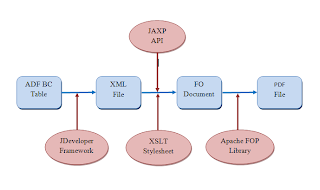Naming Standards are very important to organize the code, especially when you are working with large scale applications. Below are the naming conventions based on JUST my past experience
Business Components
Entity - Suffix with 'EO' - example : EmployeeEO
Updateable View Object - Suffix with 'VO' - example : EmployeeVO
Programmatic View Object - Suffix with 'TRVO' example : EmployeeTRVO
ReadOnly View Object - Suffix with 'ROVO' example : EmployeeROVO
List of Values View Object - Suffix with 'LOV' example : GenderLOV
View Link - Suffix with 'VL' example : EmployeeDepartmentVL
Association - Suffix with 'Assoc' Example : EmployeeDepartmentAssoc
View Accessor - Suffix with 'VA' Example : EmployeeNameVA
Application Module - Suffix with 'Service' example : EmployeeService
Packaging
Entities : com.<application>.<project>.model.entities
Updateable View Object : com.<application>.<project>.model.queries
Application Module : com.<application>.<project>.model.services
Programmatic View Object : com.<application>.<project>.model.trvo
View Link : com.<application>.<project>.model.vl
Association : com.<application>.<project>.model.assoc
Read only View Object : com.<application>.<project>.model.readonly
Application Naming
- Giver proper name to application , For eg : EmployeeMgmt, CustomerMgmt, VendorMgmt, etc.. The name of the application should be meaningful with respect to the functionality
Project Naming
- Give meaningful name to each project you create in any application
- Model Project :
Example : EmployeeModel, CustomerModel,VendorModel - All the model projects suffix with 'Model'
- View Controller Project :
Example : EmployeeUI, CustomerUI, VendorUI - This project holds all the User Interface related components such as .jsff, jspx, xml, etc..
- Web Service Projects
Example : EmployeeWSService, CustomerWSService, VendorWSService - All these projects contains the web services related.
- Web Service Proxies
Example : EmployeeWSProxies, VendorWSProxies, CustomerWSProxies - All these projects contains the web service proxy related files.
Business Components
Entity - Suffix with 'EO' - example : EmployeeEO
Updateable View Object - Suffix with 'VO' - example : EmployeeVO
Programmatic View Object - Suffix with 'TRVO' example : EmployeeTRVO
ReadOnly View Object - Suffix with 'ROVO' example : EmployeeROVO
List of Values View Object - Suffix with 'LOV' example : GenderLOV
View Link - Suffix with 'VL' example : EmployeeDepartmentVL
Association - Suffix with 'Assoc' Example : EmployeeDepartmentAssoc
View Accessor - Suffix with 'VA' Example : EmployeeNameVA
Application Module - Suffix with 'Service' example : EmployeeService
Packaging
Entities : com.<application>.<project>.model.entities
Updateable View Object : com.<application>.<project>.model.queries
Application Module : com.<application>.<project>.model.services
Programmatic View Object : com.<application>.<project>.model.trvo
View Link : com.<application>.<project>.model.vl
Association : com.<application>.<project>.model.assoc
Read only View Object : com.<application>.<project>.model.readonly
Application Naming
- Giver proper name to application , For eg : EmployeeMgmt, CustomerMgmt, VendorMgmt, etc.. The name of the application should be meaningful with respect to the functionality
Project Naming
- Give meaningful name to each project you create in any application
- Model Project :
Example : EmployeeModel, CustomerModel,VendorModel - All the model projects suffix with 'Model'
- View Controller Project :
Example : EmployeeUI, CustomerUI, VendorUI - This project holds all the User Interface related components such as .jsff, jspx, xml, etc..
- Web Service Projects
Example : EmployeeWSService, CustomerWSService, VendorWSService - All these projects contains the web services related.
- Web Service Proxies
Example : EmployeeWSProxies, VendorWSProxies, CustomerWSProxies - All these projects contains the web service proxy related files.

